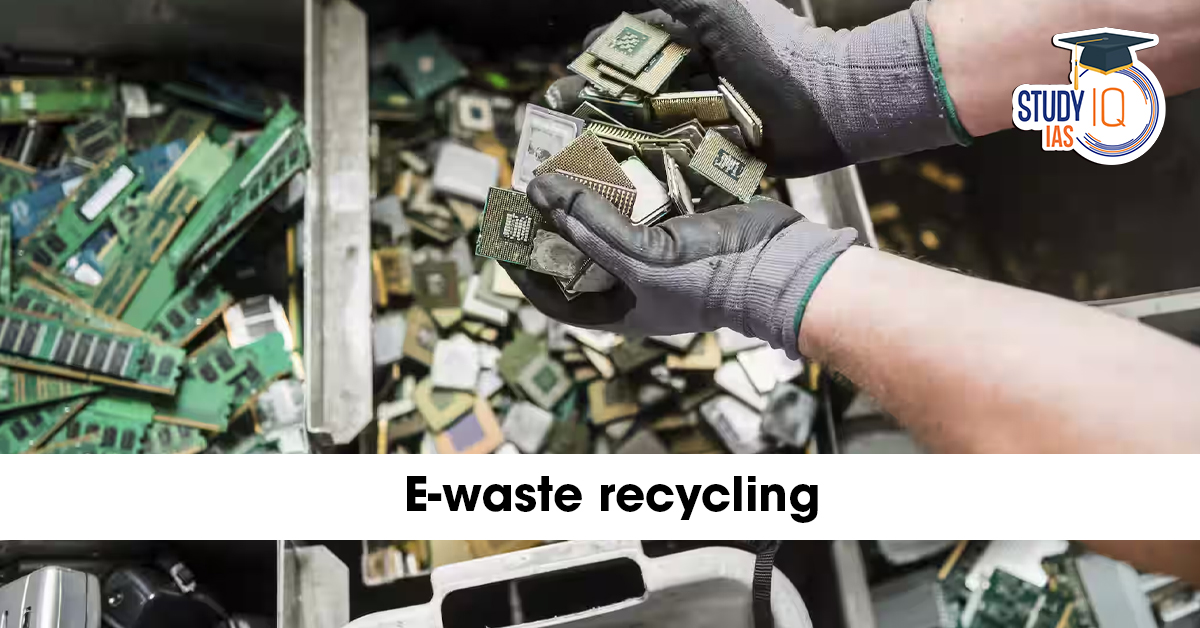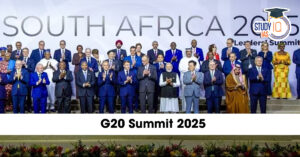Table of Contents
As India accelerates its shift toward electronics manufacturing—with initiatives like semiconductor fabrication and the Electronics Component Manufacturing Scheme—attention has increasingly turned to the less-visible but crucial sector of e-waste recycling. With millions of tonnes of discarded electronics piling up annually, policymakers are eyeing the recovery of precious metals and rare earth elements (REEs) as a strategic priority. However, the persistence of informal recycling channels, policy loopholes, and inadequate traceability mechanisms hampers the transition to a formal, circular economy.
Why E-Waste Recycling Matters for India’s Economy and Security
India consumes just about 4% of the world’s electronics, but its consumption is projected to expand rapidly due to digital penetration, 5G expansion, and rising disposable incomes. At the same time, global supply chains for critical minerals—particularly rare earth elements—are becoming increasingly volatile due to geopolitical tensions. For instance, China’s export restrictions on REEs earlier this year exposed India’s dependence on foreign sources.
Recovering metals like copper, aluminium, nickel, cobalt, lithium, steel, and gold from discarded electronics is not just an environmental necessity—it is an economic and strategic imperative.
Government Initiatives: EPR and Mineral Recycling Schemes
The Union government has announced several measures to formalise recycling:
-
Extended Producer Responsibility (EPR) for electronics and appliances.
-
A ₹1,500 crore mineral recycling scheme announced in September.
-
Push for domestic manufacturing via PLI schemes and import substitution.
Under EPR, manufacturers are required to collect end-of-life products and ensure safe extraction of reusable materials. However, implementation continues to fall short of intentions.
Role of Precious Metals and Rare Earths
Electronics contain small but significant quantities of valuable elements. With the global race for critical minerals accelerating, recycled metals can be a game-changer for reducing import dependence.
Some key recovered materials include:
-
Gold
-
Copper
-
Aluminium
-
Steel
-
Nickel and Cobalt (batteries)
-
Lithium (EVs and electronics)
Industry insiders argue that with the right policy push, India could meet up to 70% of its rare earth requirements within 18 months through recycling.
Informal Sector Dominance: A Structural Hurdle
A 2023 report by the Indian Cellular and Electronics Association (ICEA) flagged the biggest challenge: India’s e-waste sector is largely dominated by the informal economy.
These informal units:
-
Focus on repair and resale rather than recycling.
-
Harvest components manually, often using unsafe methods.
-
Operate outside regulatory oversight.
-
Prevent recovered materials from entering formal supply chains.
While repair and reuse contribute to sustainability, they also complicate material traceability and undermine large-scale metal recovery.
Malpractices and “Paper Trading” Under EPR
Even within the official framework, compliance remains problematic. Reports indicate that some authorised recyclers inflate recycling volumes to claim incentives and benefits.
Dr. Sandip Chatterjee, adviser at Sustainable Electronics Recycling International (SERI) and a veteran policy expert, highlights:
“Some of the players are indulging in malpractices to earn financial benefits without having either the capability or the capacity for metal extraction.”
He emphasises the need for:
-
Third-party audits
-
Downstream vendor due diligence
-
Environmental safeguards
-
Material tracking until final disposal
Material Traceability and Inventory Gaps
Unlike Western countries, India does not treat every sold electronic device as a future e-waste unit upon purchase. Gadgets often move across multiple owners and informal resale markets before disposal, making tracking difficult.
Dr. Chatterjee points out two major inventory issues:
-
No uniform method of tracking by State Pollution Control Boards.
-
Informal reselling hides true volumes of potential recyclable material.
This leads to conflicting estimates between Indian agencies and international organisations.
Scale of the Problem: Data Estimates
-
4.17 million metric tonnes of e-waste was generated in India in 2022.
-
Only one-third of this was processed through “proper channels.”
-
The rest is handled by informal workers with no regulation, safety, or reporting.
This massive gap highlights both the opportunity and the implementation crisis.
Auditing and Crackdown: Efforts Underway
In the last five months, the Central Pollution Control Board (CPCB) has audited over 50 recycling firms. Those found overstating recycling figures or lacking processing capacity are under regulatory action.
This marks a shift from passive regulation to active enforcement, but coverage remains limited.
Industry Response: Attero’s Formalisation Model
Attero, a major recycling firm, has adopted a “mandi-style” aggregation model, integrating informal collectors into formal recycling networks. Founder Nitin Gupta notes:
-
Precious metals recovery from domestic e-waste is currently negligible.
-
But with better policy alignment, India could supply most of its own REEs.
-
Recovery of gold, copper, aluminium, and steel is already significant.
This model shows how informal networks can be co-opted into formal frameworks rather than eliminated overnight.
Challenges to Circular Economy Implementation
Despite policy intent, several roadblocks persist:
1. Informal Sector Fragmentation
Dominance of unregistered handlers limits raw material flow to authorised recyclers.
2. Inadequate Enforcement
State-level boards lack uniform standards and cohesive tracking mechanisms.
3. Lack of Awareness and Incentives
Consumers and small businesses often discard electronics through kabadiwalas without formal documentation.
4. Regulatory Loopholes
Paper trading and false reporting under EPR remain concerns.
5. Technology Gaps
Not all recyclers have the machinery or expertise for high-quality metal extraction.
Way Forward: Policy Reforms and Solutions
To unlock the potential of e-waste recycling for resource security, India needs a multi-layered strategy:
Formalisation of the Informal Sector
-
Cluster-based integration
-
Training and incentive mechanisms
Standardised Inventory Tracking
-
Digital product lifecycle tracking
-
Uniform protocols across states
Stronger EPR Enforcement
-
Third-party audits
-
Penalties for non-compliance
Encouraging Repair with Traceability
-
Incentives for repair chains to register
-
Product lifecycle visibility mechanisms
Building Domestic Extraction Capacity
-
Support for smelting, separation, and REE refining
-
Public–private partnerships
Conclusion
E-waste recycling in India sits at the intersection of environmental responsibility, economic opportunity, and strategic self-reliance. While the informal sector plays a vital role in repair and reuse, its unregulated dominance prevents the development of a scalable, circular economy.
With geopolitical uncertainties and supply chain vulnerabilities growing, India must move beyond policy announcements to institutional capacity-building, accountability, and coordinated execution. If successful, e-waste could become not just a waste management issue, but a foundation of India’s resource resilience and manufacturing future.


 Commonwealth Games Host Cities (1930–2...
Commonwealth Games Host Cities (1930–2...
 G20 Summit 2025 Johannesburg: Full Outco...
G20 Summit 2025 Johannesburg: Full Outco...

























